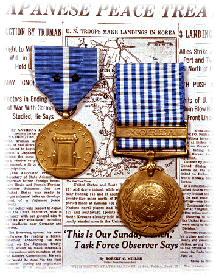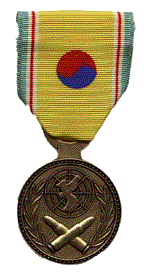Korean Service Medal
President Harry S Truman created the Korean Service Medal with Executive Order No. 10179, of 8 November 1950 to commemorate the service of members of the Armed Forces of the United States during operations in the Korean area.
a. Eligibility for the medal (at left in photo) is based on the following:
(1) Duty must be performed in Korea, including the waters adjacent thereto within the following limits: From a point at latitude 39 · 30" N., longitude 122 · 45' E., southward to latitude 33 · N, longitude 122 · 45' E; thence eastward to latitude 33 · N., longitude 127 · 55' E.; thence northeastward to latitude 37 · 05' N., longitude 133 · E.; thence northward to latitude 40 · 40' N., longitude 133 · E.; thence northwestward to a point on the east coast of Korea at the juncture of Korea with the U.S.S.R.; or in such areas as Commander, Naval Forces Far East considers has having directly supported the military effort in Korea.
(2) Such duty must have been performed between 27 June 1950 and 27 July 1954.
(3) Sea Duty. - Service for one or more days in the designated area while attached to and serving on board a vessel of the Navy or Coast Guard, or other vessel to which regularly assigned for duty.
(4) Shore duty. - Attached to and regularly serving on shore in the designated area for one or more days with an organization that is participating in combat operations or in direct support of combat missions.
(5) Temporary Additional Duty. - Service of 30 consecutive days or 60 nonconsecutive days in prescribed area is required for personnel on temporary additional duty, except in cases wherein a vessel, aircraft, or unit engages in combat with, attacks, or is attacked by enemy forces, at which time all United States naval personnel serving in the vessel, aircraft, or other unit shall immediately become eligible for the medal without reference to time limit.
(6) Passengers. - No individual en route in a purely passenger status, i.e., observer, visitor, courier, or escort, shall become eligible for the medal unless the means of conveyance on which he is traveling is attacked by or engages in combat with the enemy. In the latter case he shall become eligible for the medal on the occasion of the attack or combat.
(7) Patients in hospital ship. - Personnel embarked in a hospital ship for passage as a patient shall be considered as attached to the ship.
The medal was designed by Thomas Jones, a sculptor on the staff of the Army Institute of Heraldry. The front, or obverse, depicts a traditional Korean gateway while the back, or reverse, shows the Taegut or Yin-Yang symbol taken from the South Korean flag.
At right in the photo is the United Nations Korean Medal. All members of the naval service of the United States who are eligible for the Korean Service Medal under existing regulations are automatically eligible for the United Nations Korean Medal.
The medal was initiated by U.N. General Assembly Resolution 483 (V) of 12 Dec. 1950. Presidential acceptance of this award for the U.S. Armed Forces was announced by the Department of Defense with its directive No. 110 23-3 of 27 Nov. 1951.
Originally entitled the "United Nations Service Medal" in the mid-1950s, a 1961 UN administrative change redesignated it the "United Nations Korean Medal."
The designer and precise symbolism of the United Nations Korean Medal are not given in standard references. The polar azimuthal equidistant projection view of the globe encircled by an olive wreath is the universal symbol of the world body, a design which the group has used since its organization in 1945.
The light blue in the ribbon - and in all emblems of the United Nations - was selected as a hue that did not appear in the flag of any member nation at that time of its creation. One anecdote suggests that the shade was designated "Stettinius Blue" in honor of Edward R. Stettinius, U.S. Secretary of State and leader of the United States delegation to the conference. The Army's Institute of Heraldry lists the color officially as "Bluebird."
No official reason is given for the 17 vertical stripes, but it is an important fact that 17 member nations officially bore arms as part of the U.N. forces in Korea (Australia, Belgium, Canada, Colombia, Ethiopia, France, Greece, Luxembourg, Netherlans, New Zealand, Philippines, South Korea, Thailand, Turkey, Union of South Africa, United Kingdom and the United States. Denmark and Italy provided medical support only). Approximately 1 million service members of the United Nations and South Korea combined participated in the action.
The clasp illustrated is in English, but the medal itself was issued with clasps and reverses in approximately a dozen different languages to accommodate the native languages of participating member nations. The blue-and-whilte ribbon design is common to all the various medals, except that the Turkish version often is seen with a simple dark red ribbon replacing the blue-and-white version, a symbolic rejection of a color scheme the Turks perceived as representing the flag of historical rival Greece.
Korean War Medal
Recently, the Defense Department has announced that Korean War veterans may accept and wear the (Republic of Korea) War Service Medal.
It first was offered on Nov. 15, 1951, by the South Korean Minister of Defense to the Commander-in-Chief of the United Nations Command. The medal was intended for award to those who participated in the Korean War for at least 30 consecutive days or 60 nonconsecutive days on or after June 25, 1950.
In his original offer, the Korean Minister of Defense stated that, "It is requested that you accept the Republic of Korea's recognition of the splendid service rendered by the United Nations command and delegate authority to commanders of forces of the nations fighting in Korea to award the Korean War Ribbon to members of their commands."
The United States acknowledged the offer but turned it down. Over the years many Korean War veterans had tried to get the Defense Department to accept the medal, but to no avail. In 1996 the Army noted that it could find no record that the Korean Government ever offered the medal to the Department of Defense, which was technically true: the original offer was made to the United Nations Command. The Army then took the position that unless the Korean Government resurrected their original offer, the Army was "not in a position to officially recognize or approve acceptance of the medal."
Interestingly, a number of other countries that participated in the Korean War did accept the medal, and examples are found in medals groups from those countries. On August 20, 1998, Francis M. Rush Jr., Principal Deputy Assistant Secretary of the Army, approved the acceptance and wear of the Korean Service Medal.
To be eligible for this foreign award, Navy, Coast Guard and Marine Corps personnel must have:
- served between the outbreak of hostilities, June 25, 1950, and the date the armistice was signed, July 27, 1953
- been on permanent assignment or on temporary duty for 30 consecutive days or 60 non-consecutive days; and
- performed their duty within the territorial limits of, in the waters immediately adjacent to or in aerial flight over Korea while supporting or participating in combat.
Further criteria will be set forth in an amendment to Uniform Regulations. A current copy of the medal is available but does not have the Taeguk (the traditional Korean Yin-Yang symbol) woven into the drape as the originals (shown above) do.
Sources:
1953 U.S. Navy and Marine Corps Awards Manual (including 1954 changes)
Borts, Lawrence H., United Nations Medals and Missions: The Medals and Ribbons of the United Nations, Medals of America Press, Fountain Inn, SC, 1998




